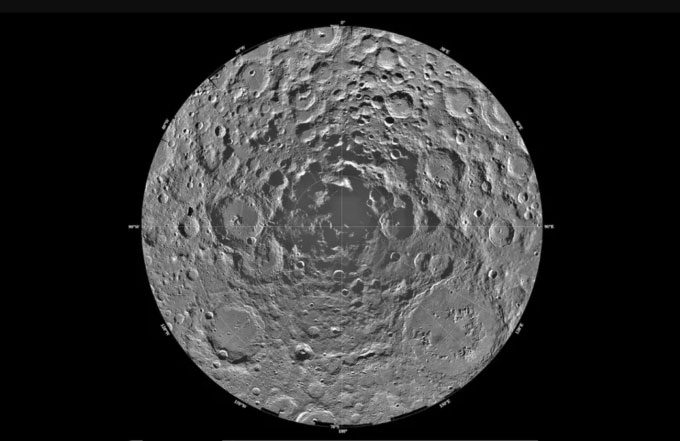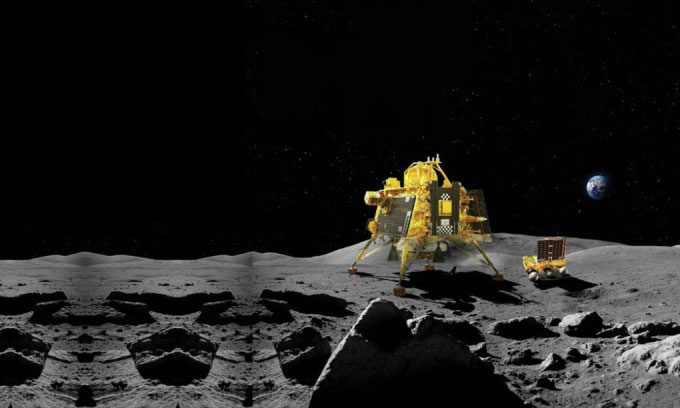The Indian Space Research Organisation plans to launch Chandrayaan-4 in 2028 to collect rock and soil samples from the Moon’s south pole.
The launch plan for Chandrayaan-4 includes collaboration with Japan to deploy a lander and an unmanned rover on the Moon, as shared by S. Somanath, Chairman of the Indian Space Research Organisation (ISRO), during a briefing in New Delhi last week.

Image of the Moon’s south pole captured by NASA’s Clementine spacecraft in 1996. (Photo: NASA/JPL/USGS).
Chandrayaan-4 aims to collect approximately 3 kg of lunar soil and rock samples from a water ice-rich area near the Moon’s south pole and return them to Earth. This mission is one of several significant recent projects approved by the Indian government to enhance its space economy. A budget of 21 billion rupees (approximately 250 million USD) has been allocated for the country’s return to the Moon.
“The Americans and Russians have done this long ago, but doing it again today remains a significant challenge – and very costly,” stated Somanath. “We are looking for ways to accomplish a Moon mission and return at a lower cost.”
The mission is designed to include five spacecraft modules, requiring two launches from ISRO’s most powerful rocket, LVM-3. The first launch will deploy a lander and a sample-collecting vehicle, while the second will deliver a transfer module and a re-entry module, which will dock in lunar orbit. According to the plan, the sample-carrying module will launch from the Moon’s surface and transfer the “cargo” to the re-entry module, which will then return to Earth.
To practice the docking of two spacecraft in orbit—one of the most challenging aspects of Chandrayaan-4—ISRO will launch a Space Docking Experiment (SPADEX) worth 14 million USD by the end of this year or early 2025, according to Deccan Herald.
Other indigenous technologies being developed for the Moon mission include a robotic arm to scoop lunar soil and a drilling mechanism to collect samples from several meters below the surface, according to ISRO.
The landing site has not been officially announced yet. Previous reports indicated that the mission would target a landing near the Shiv Shakti point, close to the Moon’s south pole, where the now-inactive Chandrayaan-3 spacecraft successfully landed.
The abundance of water ice at the Moon’s south pole makes it a significant interest for spacefaring nations, as scientists suspect this ice could be harvested to support life and serve as rocket fuel. Earlier this week, NASA selected nine potential landing sites near the Moon’s south pole for its first crewed landing, Artemis 3. China also has upcoming missions targeting the south pole, aiming to send astronauts to the Moon before the end of the decade.
“We are all excited to design and develop this complex mission—Chandrayaan-4—and bring it to fruition in 2028,” Somanath said.
Previously, in August 2023, the Vikram lander of Chandrayaan-3 successfully landed in the vicinity of the Moon’s south pole. The success of Chandrayaan-3 made India the fourth country in the world to land on the Moon’s surface, following the Soviet Union, the USA, and China. The mission also marked India’s emergence as a new space power.

Simulation of the Vikram lander and Pragyan rover in the Chandrayaan-3 Moon mission. (Photo: ISRO).
The first Moon mission in India’s Chandrayaan program was Chandrayaan-1, launched in 2008. This mission included an orbiter that mapped the Moon’s geology, minerals, and chemistry from an altitude of 100 km. After the spacecraft completed all primary mission objectives, its orbit was raised to 200 km in May 2009. The mission concluded when contact was lost with it at the end of August 2009.
In 2019, India launched the Chandrayaan-2 mission to attempt a soft landing on the Moon but faced failure. The lander and rover were destroyed upon crashing near the planned landing site of Chandrayaan-3. Meanwhile, the orbiter of Chandrayaan-2 successfully deployed and continues to orbit the Moon.


















































